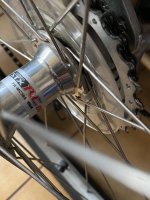For 500 miles, I had a TSDZ2 in a an old 1987 Raleigh Mtn Tour Seneca with 6 spd freewheel and the rear cogs worked well with no issues. A few weeks ago I moved the mid drive to another old Raleigh (2000 M80 w. very little use- practically new). It has a freehub 8 spd cassette and the bike jumps in and out of gears often. I tried adjusting the rear derailleur and cable tension which didn't help much. Maybe I'm not doing a good job with the adjustment?
I do not use the highest and lowest cogs and have adjusted them out with the hi/lo limit screws. I use mostly cogs 3, 4 and 5, those are the gears that jumps. Say I'm in gear 3 and pedaling, I hear a clunk, feel loss of resistance on the pedal for 1/4 of a revolution when it shifts to the next higher or lower gear.
Very annoying! Any suggestions? Keep adjusting? Get a 6 spd cassette? Get a different derailleur/ shifter?

I do not use the highest and lowest cogs and have adjusted them out with the hi/lo limit screws. I use mostly cogs 3, 4 and 5, those are the gears that jumps. Say I'm in gear 3 and pedaling, I hear a clunk, feel loss of resistance on the pedal for 1/4 of a revolution when it shifts to the next higher or lower gear.
Very annoying! Any suggestions? Keep adjusting? Get a 6 spd cassette? Get a different derailleur/ shifter?





